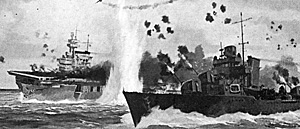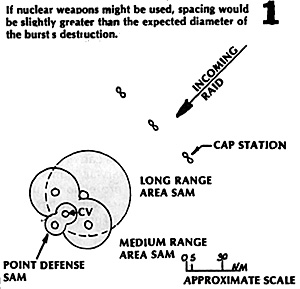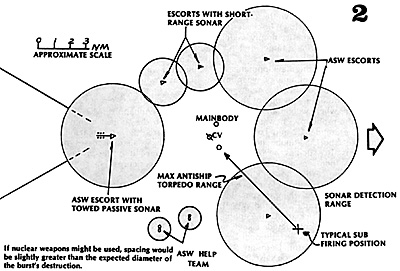 The recent appearance of several games on modern naval
warfare has caused problems for many gamers who have
bought them. Any player of WW II naval games (or games of
earlier naval eras) can draw on many sources for
information: contemporary accounts, official histories,
personal memoirs, and professional publications of the time.
He can learn by reading what tactics work and what weapon
effects are. This is not possible for a modern naval game.
The recent appearance of several games on modern naval
warfare has caused problems for many gamers who have
bought them. Any player of WW II naval games (or games of
earlier naval eras) can draw on many sources for
information: contemporary accounts, official histories,
personal memoirs, and professional publications of the time.
He can learn by reading what tactics work and what weapon
effects are. This is not possible for a modern naval game.
Most WW II battles were night engagements on the surface, with the two sides exchanging gunfire and torpedoes at close range. Carrier aircraft made daylight attacks against enemy warships with bombs and torpedoes, or attacked shore targets with bombs and machine gun fire. Submarines, originally designed as scouts for battle fleets and coastal defense vessels, became excellent merchant raiders for both sides.
Today, a modern conflict would include ships standing off at long range firing missiles with nuclear or high explosive warheads at enemy targets. These missiles would be guided by reconnaisance aircraft, or targeted via information provided by sophisticated long-range sensors. Carrier attack aircraft, armed with a mix of weapons, could attack in any weather against warships or ground targets. Ships would defend themselves against missile or aircraft attacks with supersonic antiaircraft missiles and radar-guided automatic guns. The modern submarine has reverted to its pre-World War 11 role, and is now used to support surface ships, and has an added mission: killing enemy submarines. Many people regard it as the most powerful individual ship in existence, short of a fleet aircraft carrier.
There have been no major naval combats since WWII, only small skirmishes, using "pieces" of the new technology that has totally revolutionized naval warfare since then. This lack of operational experience coupled with the complex nature of new weapons has resulted in a lack of general knowledge about tactics that might be used in a modern naval engagement.
To get a better understanding of modern naval warfare we must look at some of the fundamental characteristics of modern naval weapons systems. It will also be helpful to examine the difference between the WWII combat and today's possible conflicts.
The most obvious place to start this description is with the platforms. Ships, as always, are present. Their appearance has changed since WWII, though. Their armament is different, as we will see later. Also, they no longer depend on armor for protection, and they carry a wide variety of sensors to locate the enemy. Aircraft have changed, but in quality rather than in nature. They are more reliable, and of course much faster than their WWII counterparts. They also carry a wider variety of sensors and weapons.
The greatest change is in submarines. These platforms were effective enough in WWII, when their endurance below the surface was limited to 24-48 hours time. Their speed was also limited, because of limited battery life. At full speed the battery might last an hour, but even so the sub still could not outrun a destroyer.
A contemporary nuclear sub is totally independent of the surface, and is more maneuverable than a surface ship. It is also as fast as the surface ships operating with, or against it. A sub carries a wider range of sensors than it did in WWII, and it can attack with guided missiles and wire-guided torpedoes. The types of sensors available have also increased. Besides the obvious improvements in radar and sonar, the addition of Magnetic Anomolay Detection (MAD), Forward Looking Infra-Red (FLIR), diesel exhaust sniffers, sonoboys, Electronic Support Measures (ESM), and bottom-mounted hydrophone arrays make it much harder to hide from an enemy. Each of these senclors has its own technical characteristics and limitations, and its own effect on tactics.
Let's look at the implications of this new weapon. Firstly, IT IS NOW POSSIBLE FOR A SHIP TO DEFEND ITSELF FROM ATTACK. Before, there was very little you could do if an enemy shot at you. You tried to make him miss, or hoped your armor (if you had any) would deflect the force of the hit. Now the attacking missile can be shot down. This has made naval designers start looking at methods of defending against missile attack.
Secondly, missile (and aircraft speeds) are now almost two orders of magnitude greater than that of ships. This makes the designed speed of a ship less important. While it is still necessary for many other things, high speed will not enable a ship to evade missile fire, as it could gunfire or air attack in the past. This also means that formations in wartime must be able to defend against missile attack instantly-there is no time to deploy.
Thirdly, a battle will be over in a very short time. Most missile flight times are less than ten minutes. If it hits, there usually is not enough ship left to fight with. if it is shot down, many times the attacker won't have a lot of reload rounds. A major battle will probably consist of several short but violent engagements with the losers and victors both withdrawing rapidly: one to lick his wounds, the other to replenish his depleted ammunition stocks.
The other big difference between modern warfare and that of WWII is the possible use of nuclear weapons. These weapons have the virtue of not creating a lot of damage to the surrounding countryside as they do on land, while having tremendous destructive effect against their intended targets. They are used as missile warheads and as depth charges. The implications of using nuclear warheads are outside the scope of this article. What should be remembered is that given any serious conflict between the Warsaw Pact naval forces and those of the West, every commander must always plan as if the other side is going to use nukes, simply because the possibility exists. This possibility changes formations and tactics considerably.
The typical naval formation today consists of a taskoriented group engaged in one or more missions. The most classic is a carrier battle group (CVBG). This will consist of a carrier (CV), missile cruisers (CC), destroyers (DID & DDG) and frigates (FIF & FFG). It may or may not have one or more muclear attack submarines (SSN) in support. The formation will also have attached to it one or more auxiliaries to provide it with fuel, ammunition, and stores. The purpose of such a group will be either destruction of enemy surface forces, enemy convoys (unlikely since the USSR is a land power), or enemy installations on shore within range of its aircraft. This collection of ships represents the most powerful fighting force afloat. This power is centered mainly around the carrier's Air Group.
The CVBG uses "defense in depth" to destroy incoming attacks. Enemy submarines first face the SSNs, then the sonarbouy patterns laid by S-3 Viking aicraft, which can attack the submarines if they detect anything, then a ring of escorting ships combined with SH-3 helicopters. An air threat faces F-14s in the outer ring, with area SAMs from the CGs next, followed by short-range SAMs from the destroyers and frigates, and finally point defense weapons on the carrier and other target ships. The CVBG normally operates in support of or in conjuction with other formations.
They may be combined with it or just nearby. The most common types would be an Underway Replenishment Group or an Amphibious Group. Each of these would consist of three to six ships with DDs and FFs providing local protection while the CVBG provided an umbrella over the whole area. Special purpose formations, such as a Surface Attack group (SAG) might also be present. A SAG's mission is to attack enemy surface warships. When planning naval strategy or naval strengths in a given area, the planners usually think in terms of these groups. For instance, the standing naval force in the Mediterranean might be described as two CVBGs and one Amphibious group.
Any formation is organized around two goals: accomplishment of its mission and self-protection. For example, the first might require that a carrier have sufficient room to maneuver to launch its aircraft. This, however, requires a large area and stretches the defense thin, so the planners must compromise. The defense is usually oriented in a full circle, since an attack can come from any direction. It is also used since it allows the entire formation to change course without altering the shape (and effectiveness) of the screen.
The formation, however, never maintains a perfect circle. This would allow any observer to pick out the center (and the valuable ships) too easily. Instead, the ships will randomly maneuver within assigned areas, presenting an irregular array to any observer. Additionally, once an incoming threat is known, ships will station themselves along the "threat axis" (missile or aircraft line of flight). The attacking aircraft or missiles move so fast that they are a difficult target at best. By stationing itself along the line of flight the incoming aircraft or missile presents a steady bearing to the firing ship, and also minimizes the defending SAM time of flight, giving the ship more shots. With the short time of flight of most missiles, placing ships in a circle around the carrier means that there will usually be some ship in position to do this (hopefully more than one).
 Given this circular formation (Fig. 1), the question of what
spacing to give the ships hearkens back to the consideration
of possible nuclear warfare. If the enemy has no nuclear
weapons, normal ship handling restrictions apply, and the
ships will be spaced fairly close, with the distance to the
Guide (on whom all other ships align themselves) one to
three nautical miles. If there is a possibility of nuclear
weapons being used, the spacing will be such that a hit
could only destroy one ship.
Given this circular formation (Fig. 1), the question of what
spacing to give the ships hearkens back to the consideration
of possible nuclear warfare. If the enemy has no nuclear
weapons, normal ship handling restrictions apply, and the
ships will be spaced fairly close, with the distance to the
Guide (on whom all other ships align themselves) one to
three nautical miles. If there is a possibility of nuclear
weapons being used, the spacing will be such that a hit
could only destroy one ship.
This is of course dependent on how big a warhead you think the enemy is going to use. Formations designed to engage surface targets are currently undergoing a lot of change. Up to the late 1970's, the Navy expected carrier aircraft and submarines to destroy any enemy surface ships encountered. The wide deployment of Harpoon has now given all units a powerful anti-ship weapon. The surface threat is treated as an anti-aircraft problem, since the main weapon is the anti-ship missile. An anti-surface formation, expecting to receive enemy fire, therefore, looks a lot like an anti-air formation, but a little tighter.
 For a formation designed to protect against submarines (Fig.
2) the distance between ships in the screen will be arranged
so their sonar detection ranges overlap, preventing a
submarine from approaching undetected. If there are not
enough ships to provide an all-round sonar front, helicopters
with dipping sonar will be stationed in the gap, preventing a
sub from getting through. This nice, tight formation is great for
antisub warfare (ASW) but is lousy for antiair warfare (AAW).
For a formation designed to protect against submarines (Fig.
2) the distance between ships in the screen will be arranged
so their sonar detection ranges overlap, preventing a
submarine from approaching undetected. If there are not
enough ships to provide an all-round sonar front, helicopters
with dipping sonar will be stationed in the gap, preventing a
sub from getting through. This nice, tight formation is great for
antisub warfare (ASW) but is lousy for antiair warfare (AAW).
The idea here is to station missile ships equipped with long-rangs SAMs many miles out from the carrier, so the airplanes can be engaged before they fir e their missiles. Even if they do launch their missiles, a missile is just another air target, albeit a much harder one to hit. It should still be engaged as far out as possible, so that the carrier's own defenses can be alerted to any "leakers" that get by the screening ships. Sometimes ships equipped only with short-range defenses are stationed close to the carrier, to assist in any last-ditch defense.
This brings up the next difference between current warfare and WWII. Today's naval battle is fully "integrated"; a formation commander can expect a battle to involve all three warfare areas: air, surface, and subsurface. A submarine (ASW) may fire an antiship missile (AAW), or a ship (ASUW) may be cooperating with a submarine (ASW). This is a standard part of Soviet doctrine. In "The Great Patriotic War" (WW II) the Red Navy consistently supported its submarines with light surface craft and airplanes. One of the most widely discussed Soviet anti-carrier warfare (ACW) tactics involves coordinated aircraft and submarine attacks on the CVBG. The tactics used in the West have the same philosophy.
The problem of dealing with all three warfare areas at once, each with its own distinctive weapons, sensors, and specialized techniques is not an easy one. When added to the limited reaction time modern weapons allow, the problem of warning and coordination becomes a major concern. A missile warning over a voice radio net may take one or two minutes to act upon, while the total flight time of a missile is only four minutes! The standard now is to use computerized data links to minimize the time required to pass information. The one currently used by the U.S. Navy is the Naval Tactical Data System (NTDS). Even after a target has been assigned to a ship, the ship's weapons officer must still tell the mount to engage the target, the mount must then lock on, and only then can it fire. The new AGEIS system, mounted on USS Ticonderoga may be the way to solve this problem. It removes many of the human (slow) links in the weapons process, and is near automatic, simply asking for human approval prior to engaging a target.
The future promises many interesting developments in naval warfare. The development of energy weapons, either lasers or charged particle beams, has many applications for shipboard air defense. It is one of the applications for these weapons where weight and power requirements present less of a problem. A new generation of missiles, typified by the Standard 2 and Tomahawk, will increase the power of the U.S. fleet.
The Soviets have their own new systems also, such as the SA-N-6 and the SS-NX-19. Additionally, there are persistent rumors that the Soviets are building a carrier, not a hybrid like the Kiev or Moskva classes, but a full nuclear-powered fleet aircraft carrier. This is one area where the parallels with WW II are strong. When Germany entered WW II, she had drawn up plans for a carrier, the Graf Zepplin, which was laid down but never completed.
Like Germany in the 40's, the Soviet Union is a traditional land power trying to build up her sea arm. Germany, like Russia had to draw heavily on other nation's experience, and design an entire generation of carrier aircraft from scratch. If Hitler had not started the war too early (the admirals wanted to start it in the middle 40's), the Third Reich might have had one or two operational carriers. As it was, wartime needs meant that it was never completed.
The USSR, able to build in a peacetime environment, has more leisure to develop and practice the fine art of naval aviation. First Moskva, then Kiev, and next "?".
In summary, contemporary naval warfare is different from WWII in several specific ways: its speed, its violence, and its use of all three areas of conflict (surface, air and subsurface) simultaneously. The tactics are governed by the technical characteristics of the weapons much more than before, and the main weapon of attack is now the missile, with either a large high-explosive or a nuclear warhead. These factors mix in various ways, telling us how to design ships and how to use them in battle.
If you want to learn more about this area, the U.S. Naval Institute, Annapolis, MD 21402 has a large number of books on the subject of naval warfare, both historical and current. The magazine, U.S. INSTITUTE PROCEEDINGS, also discusses modern naval warfare in depth, since it is the professional journal of the U.S. Navy officer corps.
Miniatures games available on this subject include Warship Commander ($10) and Sea Command ($10), available from Enola Games; Harpoon ($8), available from Adventure Games; and Sea Tac ($5.95), available from Q Games. SPI publishes Task Force ($18), a good operational-level board game, and Up Scope!, a board game which covers contemporary and WWII submarine warfare on a tactical level.
I strongly encourage you to try a few games in this area. It has the flavor of science fiction in some area, but mixed with the knowledge of its immediate reality. The rules and games can give a person a much greater perspective on what is happening in the world today.
Back to Table of Contents -- Courier Vol. III #4
To Courier List of Issues
To MagWeb Master Magazine List
© Copyright 1982 by The Courier Publishing Company.
This article appears in MagWeb (Magazine Web) on the Internet World Wide Web.
Other military history articles and gaming articles are available at http://www.magweb.com